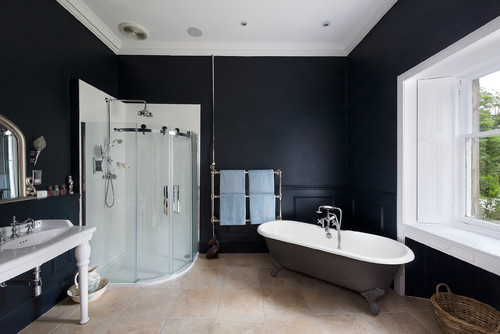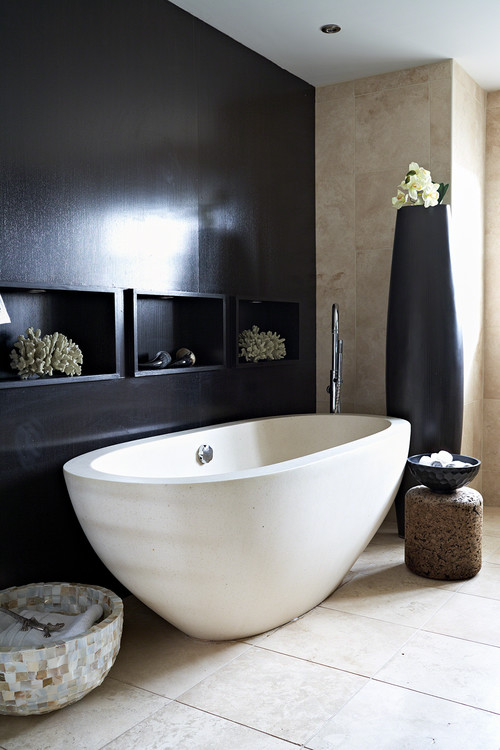Kitchen walls painted black or inky cabinets are ever more popular, but how about the other watery room in your home? Could you give your bathroom a black revamp? Let these dark and lovely schemes inspire you.

1. Go grand
Dark colors can work well in period properties. A moody paint job gives a small and dark Victorian living room a cozy boost, while a room as airy and tall as this one loses no light at all. The trick to keeping a space crisp is to contrast your inky areas with swaths of brilliant white.
Cast-iron claw-foot tubs are fairly easy to paint. You’ll need to sand it first to get a smooth surface, but use a fine-grade paper — too much abrasion could lead to rust. To guard against that, use a primer designed to tackle the orange enemy.
The top coat depends on your taste. An eggshell or soft-sheen finish will be more durable than emulsion, and more forgiving on a bumpy surface, than gloss. Be sure to use a small roller to avoid brush marks.

2. Mix materials
There’s a number of black finishes here that prevent this space from feeling flat. Again, white adds a crisp edge, but with the exposed beams and bricks, the vibe is altogether different.
If you’re tiling your bath surround, remember to incorporate an access panel. You don’t want to break up your handiwork if there’s a leak below.

3. Bridge two patterns
A solid band of color can help two clashing patterns work together. Here, the checkerboard floor and figurative wallpaper would lose impact if placed side by side. A black-painted baseboard could do the same job, but wallpaper down to the floor in a bathroom might come back to haunt you.
This tongue-and-groove paneling cuts a striking strip around the bathroom. Be sure not to dilute the effect with a white radiator. Ideally, buy yours in black since painting isn’t recommended for radiators.

4. Paint a panel
If a half-wall panel simply isn’t enough, take yours up to the ceiling. You may not be blessed with original wall woodwork, but fitting wood paneling is relatively straightforward.
It also works well when painted in a soft-sheen finish, as shown here, and looks especially elegant when gently lit.

5. Embrace au naturel
Stained black wood gives an entirely different effect than black-painted walls or paneling. In this coastal bathroom, a blackened wall ramps up the back-to-nature feel of this space. A sandstone bath, travertine-style tiles and beachy accessories enhance the look.

6. Let a feature shine
Black is a great foil for a vibrant color or pattern, or both. If you have a feature wall, backsplash, colorful bath or even a striking shower curtain, black lets it shine.
Related: Shop for Shower Curtains
This tiled walk-in shower certainly deserves the attention. If you can focus some lighting on your chosen feature, as shown here, all the better.
Note how different a grand period room looks when the window frames and ceiling are also painted black instead of white (as in photo No. 1).

7. Choose matte
Notice that little line of sparkle at the top of the half-wall on the right-hand side of the room? It stands out against the super-matte tiles and wall paint. Black serves as a strong backdrop for statement brights — and bling. On a glossy finish, however, the effect would be flashy, not subtle.
Elegant lighting on either side of the mirror adds to the quiet glamour of this space. Separate, dimmable controls for the wall and ceiling lights add a nice touch, so you can choose atmosphere over function when it suits.

8. … Or gloss
And here’s how you can make a bolder impact by using gloss finishes. The surfaces shine not only on those reflective jet wall tiles, but also on the fitted mirror.
Related: Bathroom Mirrors Reflect a Glossy Black Color Scheme
Another way to give a monochromatic space some depth and texture is to use a variety of tiles. Herringbone and small square mosaics get along nicely in this scheme. Gloss tiles can help brighten a dimly lit room by bouncing light around the space.
Would you use black in your bathroom? Tell us why or why not in the comments below!
























